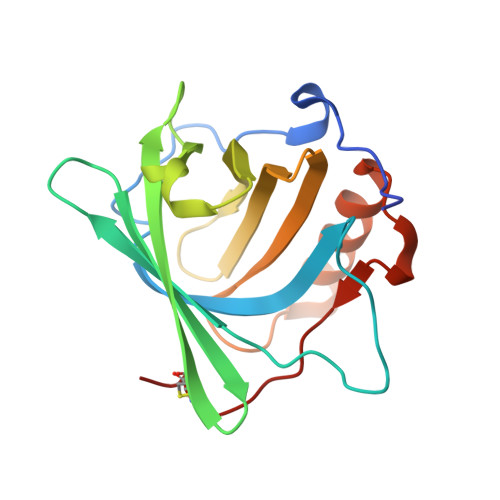Iron traffics in circulation bound to a siderocalin (Ngal)-catechol complex.
Bao, G., Clifton, M., Hoette, T.M., Mori, K., Deng, S.X., Qiu, A., Viltard, M., Williams, D., Paragas, N., Leete, T., Kulkarni, R., Li, X., Lee, B., Kalandadze, A., Ratner, A.J., Pizarro, J.C., Schmidt-Ott, K.M., Landry, D.W., Raymond, K.N., Strong, R.K., Barasch, J.(2010) Nat Chem Biol 6: 602-609
- PubMed: 20581821
- DOI: https://doi.org/10.1038/nchembio.402
- Primary Citation of Related Structures:
3FW4, 3FW5 - PubMed Abstract:
The lipocalins are secreted proteins that bind small organic molecules. Scn-Ngal (also known as neutrophil gelatinase associated lipocalin, siderocalin, lipocalin 2) sequesters bacterial iron chelators, called siderophores, and consequently blocks bacterial growth. However, Scn-Ngal is also prominently expressed in aseptic diseases, implying that it binds additional ligands and serves additional functions. Using chemical screens, crystallography and fluorescence methods, we report that Scn-Ngal binds iron together with a small metabolic product called catechol. The formation of the complex blocked the reactivity of iron and permitted its transport once introduced into circulation in vivo. Scn-Ngal then recycled its iron in endosomes by a pH-sensitive mechanism. As catechols derive from bacterial and mammalian metabolism of dietary compounds, the Scn-Ngal-catechol-Fe(III) complex represents an unforeseen microbial-host interaction, which mimics Scn-Ngal-siderophore interactions but instead traffics iron in aseptic tissues. These results identify an endogenous siderophore, which may link the disparate roles of Scn-Ngal in different diseases.
Organizational Affiliation:
College of Physicians and Surgeons of Columbia University, New York, New York, USA.



















